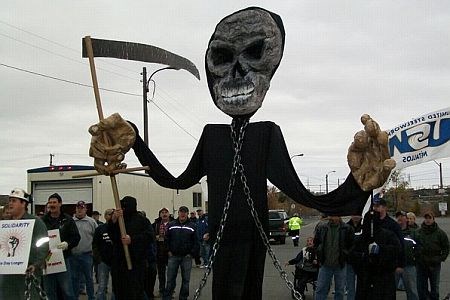With no talks scheduled and both sides firmly entrenched, the strike at Vale Inco’s Sudbury operations by the 3,100 members of United Steelworkers Local 6500 seems no closer to being resolved now than when it began, July 13.
Both Vale Inco and the Steelworkers are holding firm, trying to force the other back to the bargaining table.
Rather than staging protests in Toronto and London, England, union officials should spend their time working out a deal, says Cory McPhee, Vale Inco’s vice-president of corporate affairs.
“After four months on strike, it feels like I’m saying the same things over and over, but the truth is we didn’t want a strike,” says McPhee.
“With the nickel price where it is today, we would be profitable. But the fact of the matter is we’re not looking at the price today, a year from now or two years from now, but a long-term future for 20, 30, 40 years and putting the building blocks in place so we’ll be around for that long.”
Similarly, United Steelworkers District 6 president Wayne Fraser argues that Vale Inco should spend their money on its workers rather than its executives and bulking up on private security and lawyers for the strike.
“They say their offer is the same now as it was four months ago and that’s ludicrous,” says Fraser. “We need real negotiation.”
At issue in Vale Inco’s offer is changing the benefit pension plan to a contribution-based plan, something that would be applicable to all new workers. Also, contentiously contained in the offer is a proposed 20 per cent cap to the nickel bonus.
The company’s third-quarter results, which emerged in early November, indicated after-tax profits of $1.7 billion. The Steelworkers say this shows the mining giant’s future is brighter than it claims and the need for concessions is overblown.
However, McPhee says those profits have largely stemmed from its iron ore division and do not reflect the fiscal reality of the Vale Inco division, which continuously lost money during the previous year. Long-term prospects will require further belt-tightening to remain sustainable, he adds.
The Copper Cliff smelter will require $1.5 billion to meet emissions standards by 2015. Vale Inco will also be forced to dig deeper for ore throughout its operations, increasing costs without increasing production or profits.
In the meantime, Vale Inco has trained 50 members of non-striking Steelworkers Local 2020 and put them alongside “hundreds” of non-unionized staff to operate the Clarabelle Mill and resume some production at the Coleman and Garson Mines. Others are being trained to run the smelter, though no decision has been made as to whether it will be brought back online.
This move, unprecedented in a Sudbury strike, is about providing some revenue to the business, says McPhee.
Fraser disagrees, arguing that it’s about making a statement.
“This is not a financial struggle, but a power struggle,” says Fraser. “It’s about making a culture shift in the Sudbury Basin.”
Since the strike started, the working membership has likely dropped from 3,100 to 2,950, says Fraser, with many taking retirement or walking away rather than deal with the poisonous atmosphere.
Regardless of the disagreements, the strike has created economic ripple effects throughout the North.
Northern Ontario mining service and supply firms are seeing a flattening of demand, and volumes are “significantly” down across the city and the region, according to Dick DeStefano, Sudbury Area Mining Service and Supply Association executive director.
Although employment has stabilized and some companies have taken the down time to rebuild, there’s an average workforce reduction of 25 per cent across the North’s suppliers, says DeStefano. Making use of reduced workweeks, many companies have kept their doors open and there still likely remains 4,000 employed in the service and supply industry through the North, he says.
Other producers in the North have also begun to feel the pinch, such as Xstrata Nickel, which was forced to shut down its copper operations at Timmins’ Kidd Metallurgical Site for 10 weeks this fall, affecting 200. On Nov. 12, FNX Mining announced a third-quarter loss of $58.5 million, attributed in part to production at Sudbury operations being stockpiled as inventory instead of being processed by Vale Inco.
The lengthy strike has begun to draw sharp words from other municipalities. Sault Ste. Marie Mayor John Rowswell wrote an open letter to both sides urging a swift resolution to the conflict. He said the rest of the region “does not appreciate both sides undermining the economy of communities in Northern Ontario.”
Arguing that the public will begin to turn on both parties, Rowswell added “to suggest that the credibility of both sides is being severely eroded is an understatement.”
Those hoping for Sudbury’s dark mining cloud to lighten, however, may see some concern on the horizon, as Xstrata Nickel’s Mine Mill/CAW Local 598 is due for contract talks in February 2010.
www.local6500usw.ca
www.inco.com




